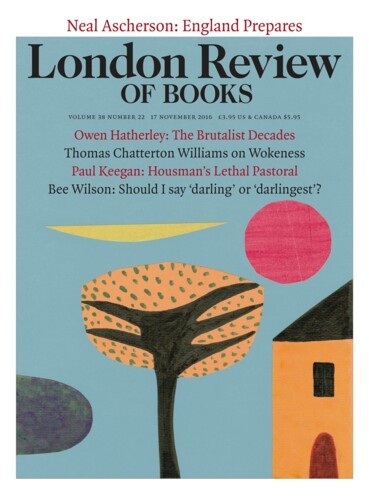In 1948 Allan Wingate published British Pamphleteers, a collection of tracts assembled by Richard Reynolds and introduced by George Orwell. The first pamphlet in the book is John Knox’s First Blast of the Trumpet (1558), which begins: ‘To promote a woman to beare rule, superioritie, dominion or empire above any realme, nation, or citie, is repugnant to nature, contumelie to God, a thing most contrarious to his reveled will and approved ordinance, and finallie it is the subversion of good order, of all equitie and justice.’ The sentence is like a jolt of electricity, both for Knox’s contemporaries (though few would have disagreed with him in principle) and for us. His arguments – and those of the other writers, known and anonymous, Reynolds gathered together – were angry, exposing the faultlines in Tudor thought about religion and politics, and speaking for a world much less settled than we might imagine. A manuscript satire from the 1590s included in the book shows Queen Elizabeth I as a puffed up hen: the only concession to Her Majesty’s dignity is the steady eye that peers out from a great ruff of feathers. More ridiculous than glamorous, Elizabeth’s pretensions are reduced to the vanities of an ageing queen. Sharp and subversive, the image is gritstone to the polished marble of the Elizabethan reputation.
Antiquaries and historians have wrestled with Elizabeth from the outset: first there was William Camden’s ponderous official history, then the influential courtier biographies by Robert Naunton, Froude’s probing critique, the rigorous constitutionalism of A.F. Pollard, and so on to John Neale, his pupils and colleagues, and beyond to Peter Lake and John Guy. So often studies of Elizabeth’s reign are impossible to disentangle from the moment when they were written, whether from Victorian and Edwardian confidence in robust parliamentary government, or from post-imperial decline, or the ideological strains of the Cold War, or even our present fixation with sex and celebrity. Historians these days aren’t afraid to try their hand at psychoanalysis, or to unlock Elizabeth’s bedchamber.
From the beginning Elizabeth did her best to resist scrutiny, protecting her privacy as best she could. She wrote as a teenager in about 1548: ‘It is … rather characteristic of my nature not only not to say in words as much as I think in my mind, but also, indeed, not to say more than I think.’ And yet for a long time that blank mask of royalty, essential to the Renaissance prince, has been slipping. The woman modern scholarship gives us has been neatly summed up by David Cannadine: ‘A workaday regnant queen, shorn of her glitter and her gold, her glamour and her greatness, with a false face, a disturbed psyche, a heart of stone, a barren womb and feet of clay; and as such a woman trying to do a man’s job, but not always doing it very happily or well.’
From this continuous rewriting of Elizabethan political history, a number of themes stand out. The first is life at the queen’s court, for so long and for the most part made sense of in terms of faction-fighting between courtiers, but now understood in terms of ripples disturbing otherwise calm political waters, at least in the early decades of her reign. If equilibrium was occasionally upset by a new court favourite or power broker (Robert Dudley, say, or Christopher Hatton), or sometimes a policy (on military intervention abroad, perhaps, or, most divisive of all, on marriage alliances for the queen), much of the time the court functioned well. The challenge was to keep things going: to make policy and navigate differences of opinion; to keep an eye on the management of Elizabeth by her advisers and their management by Elizabeth, on courtiers’ hopes of preferment, promotion and patronage (and pique at not getting it); on gossip, rumour, etiquette and protocol, reputation and ego. In all of this William Cecil (later Lord Burghley) was the master. ‘The court hath the trees of paradise,’ he wrote in 1569, from which grew the knowledge of good and evil – courtiers could flourish or fail, and staying power counted. To make sense of the bubble in which Elizabeth and her servants lived, scholars accept the coexistence in Elizabethan court politics of essential harmony and potential rivalry.
The limitations on Elizabethan governance were not different from those faced by many governments in other times and places. The queen’s advisers sought plausible, easy and cheap solutions to complex and expensive problems. Sometimes this was because Elizabeth refused to spend the money in her exchequer; sometimes it was because a particular problem – it might be the Church, the governance of Ireland, relations with Spain, the economy – was too difficult to make sense of administratively or imaginatively. Cecil understood the way day-to-day politics worked: ‘An ounce of advise is more worth to be executed aforehand than in the sight of perils. But as long as I have served the queen’s majesty, Epimetheus [“Afterthought”] hath had more to do than Prometheus [“Forethought”].’ Naturally he cast himself as Prometheus. If tactical thinking was this difficult to achieve, then longer-term strategic planning was more or less impossible.
The last thirty years of scholarship have revealed the scale of the challenge facing Elizabeth and her councillors and courtiers. The belief that Elizabeth’s Protestant England faced down its European Catholic enemies with confidence is long gone. There’s no evidence that the Church of England and the English prayer book were enthusiastically embraced by Elizabeth’s subjects. They weren’t, and even some of those within the Church, archbishops, bishops and ministers, thought that reformation hadn’t gone far enough. No great unifying ‘middle way’, the Elizabethan ‘settlement’ settled nothing at all. Old assumptions (like Knox’s about female rule) and new arguments toxic to the authority of monarchs had mutated in the decades following Henry VIII’s break with Rome in the 1530s and the Marian burnings of the 1550s.
Disgusted at England’s heresy, and coming increasingly within the scope of treason law, English Catholic émigrés and exiles launched ferocious attacks on Elizabeth’s advisers, and eventually on the queen herself. As the years ticked by England became more and more isolated diplomatically. A cold war with Philip II of Spain had turned by the 1580s into military intervention in the Low Countries and France, and war at sea. With her rival claim to the Tudor throne, Mary Queen of Scots made Elizabeth’s refusal either to marry or to name a successor the most divisive political question for two or even three generations.
And so for many decades the Elizabethan political world was in crisis. To read the policy and position papers of Elizabeth’s councillors and officials is to find yourself in a bunker: enemies were both outside and within, the kingdom was under assault, the forces of Antichrist looked likely to overwhelm England. This was the narrative Protestant Elizabethans internalised and used to make sense of their world. Here the scholarship of Patrick Collinson, to which Lake’s Bad Queen Bess? is a critical response, was transformative, showing nothing less than a politics of emergency, with privy council and parliaments pressing to execute Mary Queen of Scots and mobilise loyal Protestant subjects against the Catholic danger, despite Elizabeth’s strenuous resistance.
Lake gives us a fresh and arresting perspective on Elizabethan politics and religion. One strand of his argument is that historians have tried above all to get inside the minds of those Protestant Elizabethans in the bunker. He wants us to see instead the parallel reality experienced by English Catholics, especially by those (William Allen, Robert Persons, Nicholas Sander and others) who wrote against what they saw as Elizabethan tyranny and persecution.
Tudor tyranny could be resisted in a number of ways. Open revolt was one method, but cheaper, easier, generally safer and in many ways more effective was the printing press. Elizabethans quickly learned the power of the written word as an instrument of irregular warfare. What Orwell in 1948 identified as the qualities of the pamphlet applied as much to the 16th century as they did to the 20th: one can see lines of continuity from Leicester’s Commonwealth (a libel that exposed as a dastardly criminal and deviant Elizabeth’s first court favourite, Robert Dudley) all the way, via Swift, to Frank Owen’s Guilty Men, published in 1940. Orwell wrote: ‘A pamphlet is never written primarily to give entertainment or to make money. It is written because there is something that one wants to say now, and because one believes there is no other way of getting a hearing. Pamphlets may turn on points of ethics or theology, but they always have a clear political implication.’ For historians, this immediacy is the problem, with the added challenge that for the years between 1570 and 1600 pamphlets came not just singly or in short exchanges but as whole barrages of polemic. Allen and his fellow Catholics were talented logicians, theologians and rhetoricians; they were also in need of funding and political support. Their writings spoke to the moment, and they courted foreign leaders such as Philip of Spain. The question is, how do we find coherence in words which were so often spat at Elizabeth’s government in holy rage?
Lake’s achievement in Bad Queen Bess? is to tease out of those thousands of words a sustained Catholic counter-position, something supple and sophisticated, that was not simply about self-serving efforts by desperate men who would do or write anything to denounce Elizabeth or the mob of heretics (Cecil chief among them) she had appointed to advise her. Lake sees ‘political thought’ not so much as a canon of texts admired for their scholarship, but rather as a series of moving engagements with political circumstances. The pamphlets he puts under scrutiny kept to certain arguments: they addressed the nature of the authority to govern in matters temporal and spiritual and the right of subjects to resist that authority. But they were fluid also, and had polemical force.
It’s no wonder Cecil was so often the object of the émigrés’ venom, given his power and influence at Elizabeth’s court. He pulled no punches. Though not naturally a polemicist, he was the master manipulator of the official printing press and the committed, if often frustrated, suppressor of Catholic pamphlets and libels he obtained from ambassadors and other officials abroad.
Lake shows how the polemicists struck again and again at the villainy of the Elizabethan regime by condemning ‘politique’ and ‘machiavel’ courtiers who, politically and psychologically, held the queen prisoner. If this looks at first like a rather tired literary device (or if we are tempted to explain it away simply as the polemicists’ disingenuousness), Lake shows that something else is going on: not just an appeal to angry or anxious Catholics but to Elizabethans alienated by extremist positions. This, he argues, enabled the writers to express loyalty to the queen and present their works as ‘truth-telling exercises in good rather than in evil counsel, attempts to reveal to both prince and people the dastardly plots of the politique conspirators who had hijacked the kingdom’.
Of course this is easy to dismiss as enemies posing as friends and fiction as truth; authorship and place of publication were often fabricated and pamphlets circulated underground. And yet Lake’s close analysis of Leicester’s Commonwealth suggests how far that libel gave shape to rumours about Robert Dudley that were already circulating. The pamphleteers were giving existing material further shape and then offering it back to sympathetic readers. Lake takes into account print, gossip and news, and so gives subtlety and depth to his reconstruction of political debate and discussion in the otherwise highly controlled conditions of suppression and censorship under Elizabeth.
Where Lake takes us through the looking glass to the bitter Elizabethan war for authority, conscience and God, John Guy takes us behind the arras to Elizabeth’s court in the last years of the reign. This, too, is unfamiliar territory. Elizabeth’s later years are not very well known; many historians (with some distinguished exceptions) have succumbed to a kind of post-Armada exhaustion. The 1590s were not happy years, and for many of Elizabeth’s subjects the grand sentiments of Theodore Beza (translated by Richard Hakluyt) following the defeat of the Grand Armada would have sounded ironic:
And now, O Queene, above all others blest,
For whom both windes and waves are prest to fight,
So rule your owne, so succour friends opprest,
(As farre from pride, as ready to do right)
That England you, you England long enjoy,
No lesse your friends delight, then foes annoy.
The realities were war, an exhausted royal exchequer, squabbling courtiers, fallings-out over policy and patronage, an irascible queen and proletarian grumblings about dearth and military conscription.
To get to all this, Guy strips away the old layers of literary invention and antiquarian obfuscation, going back through Neale to Lytton Strachey, Froude, Camden and others. The brilliance of Elizabeth: The Forgotten Years lies in the energy of its narrative, as well as in Guy’s eye and ear for scene and conversation. To interweave all this with the life of the queen is a formidable achievement. He has captured the complexity of contemporary politics; hedged in by very many things (the world of political possibilities, then as now, seems such a narrow one), the room for diplomatic and military manoeuvre was limited.
Most striking is Guy’s portrait of Elizabeth. Here is Gloriana utterly deflated, for much of the time at Nixonian levels of self-deception. There is a sense of a woman who no longer had the strength to contain within her physical form (her body natural) the majesty of rule and governance (the body politic): one was rejecting the other. At times Elizabeth’s voice was as subtle and as supple as it always had been, controlled and persuasive, given shape by rhetoric and modulated by instinct. She could be in command, dictating a letter of rebuke to Robert Devereux, second Earl of Essex in 1589: ‘So we look to be obeyed, and to have obedience directly and surely continued unto us, and so look to be answered herein at your hands. Otherwise we will think you unworthy of the authority ye have, and that ye know not how to use it.’ She had a talent for economy of speech, as she told her councillors in 1597: ‘I will not make wars but arm for defence.’ Even Elizabeth’s sense of her own mortality was reduced to a single, witheringly direct question: ‘Think you that I could love my own winding sheet?’
Yet Elizabeth was fragile and her health was poor: she suffered from debilitating migraines, insomnia, depression and at times disconcerting swings of mood. She detested getting older, and lashed out at the young and pretty gentlewomen of her private chambers. For the first time we have an accurate and critical account of the audiences between Elizabeth and the French ambassador de Maisse in 1597. Although once, through mistranslation and misinterpretation, Elizabeth at 64 appeared before de Maisse in a state of erotic provocation, in fact little flesh was on display: Elizabeth merely wanted to show the ambassador her taste for the latest fashions. Still, she looked her age, and de Maisse wrote:
As for her face, it is and appears to be very aged. It is long and thin, and her teeth are very yellow and unequal, compared with what they were formerly, so they say, and on the left side less than on the right. Many of them are missing so that one cannot understand her easily when she speaks quickly.
How awkwardly the facts sit with the queen’s portraits in the 1590s, the most famous of which were imaginative celebrations of Elizabeth couched in consciously classical terms: the outstanding example here is the Rainbow Portrait by Marcus Gheeraerts the Younger. But there was no suppression or destruction of images that Elizabeth or her council found offensive. Isaac Oliver’s miniature of the queen at 59, for example, is compellingly realistic. It was not suppressed, nor were the prints taken from it: Oliver simply received no other royal commission.
In 1566 Cecil wrote to an ambassador: ‘Briefly I affirm that the queen’s majesty may be by malicious tongues not well reported. But in truth she herself is blameless and hath no spot of evil intent.’ Thirty years later her courtiers and councillors were less forgiving. Here, again, we sense Elizabeth’s fragility. She spoiled and indulged the young second Earl of Essex whose extraordinary misjudgments and character flaws build throughout the book. Elizabeth may have been rash, petty and given to reprisals against those who had offended her, but her courtiers had an equal ability to outmanoeuvre her. At times the sense of claustrophobia is overpowering – a decaying queen and a broken political system at war with itself over both patronage and policy, more Titus Groan than The Faerie Queene.
Hanging over everything in the 1590s was the future; or rather, in terms of the succession, the obvious lack of one. The execution of Mary Queen of Scots in 1587 had merely opened up a new phase in the contest between plausible (and not so plausible) candidates. The Stewarts had staying power: in the 1590s the next monarch looked likely to be King James VI of Scotland, Mary’s son, who was given an English pension to make sure that he was a good boy – Elizabeth gave him no explicit assurance. Catholic polemicists had their own ideas. Robert Persons’s A Conference about the Next Succession to the Crown (1593-95), which argued the case for Philip II’s daughter, the Infanta Isabella, was a formidable and furious piece of writing that became an underground bestseller and provoked fury in government. Here the Elizabethan worlds of Lake and Guy meet. Persons’s fake dedication of his pamphlet to the Earl of Essex – ‘for that no man is in more high and eminent place or dignity at this day in our realm, than yourself’ – was a touch as masterful as it was malicious.
In the end it wasn’t Elizabeth who saw to the safe transition of rule. It was Burghley’s son, her secretary Sir Robert Cecil, who conducted secret negotiations with James through intermediaries. It was, simply, a necessary fix. Reflecting on it, Cecil wrote: ‘If her Majesty had known all I did … her age and orbity, joined to the jealousy of her sex, might have moved her to think ill of that which helped to preserve her.’ His words are more damning of Elizabeth than the futile act of rebellion that had taken Robert Devereux to the executioner’s block in 1601, for Cecil spoke of a necessity beyond the will of the queen – not passion or temper but cool political logic. For her councillors and courtiers, Elizabeth was everything and nothing. They accepted her mortality and were prepared to act, ‘wholly bent’ (as Cecil put it) ‘to accommodate the present actions of the state for his [James’s] future safety, when God should see his time’. Reading words like these, and perceiving the assumptions that lay behind them, we might even wonder whether the government’s Catholic critics were so very far from the mark.
Send Letters To:
The Editor
London Review of Books,
28 Little Russell Street
London, WC1A 2HN
letters@lrb.co.uk
Please include name, address, and a telephone number.




